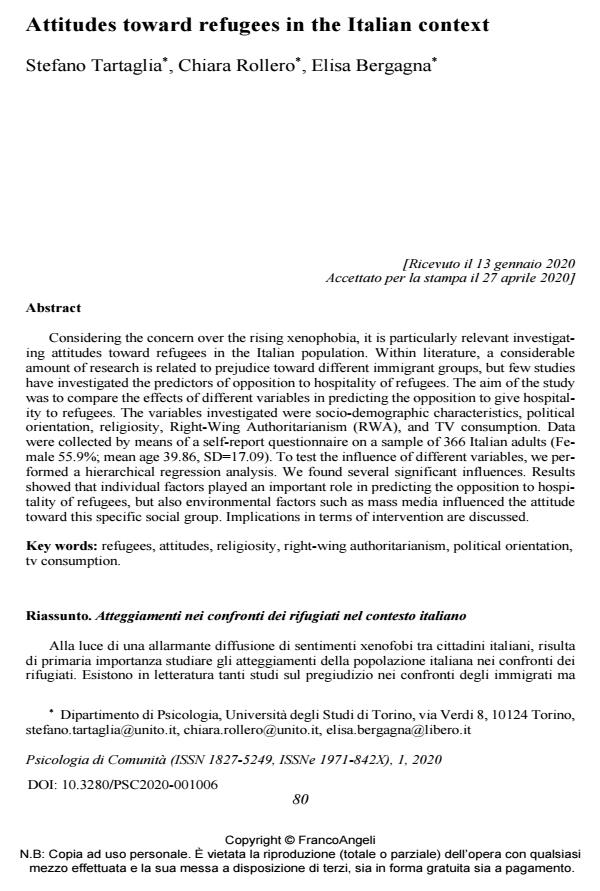Attitudes toward refugees in the Italian context
Journal title PSICOLOGIA DI COMUNITA’
Author/s Stefano Tartaglia, Chiara Rollero, Elisa Bergagna
Publishing Year 2020 Issue 2020/1
Language English Pages 13 P. 80-92 File size 645 KB
DOI 10.3280/PSC2020-001006
DOI is like a bar code for intellectual property: to have more infomation
click here
Below, you can see the article first page
If you want to buy this article in PDF format, you can do it, following the instructions to buy download credits

FrancoAngeli is member of Publishers International Linking Association, Inc (PILA), a not-for-profit association which run the CrossRef service enabling links to and from online scholarly content.
Considering the concern over the rising xenophobia, it is particularly relevant investigating attitudes toward refugees in the Italian population. Within literature, a considerable amount of research is related to prejudice toward different immigrant groups, but few studies have inves-tigated the predictors of opposition to hospitality of refugees. The aim of the study was to compare the effects of different variables in predicting the opposition to give hospitality to ref-ugees. The variables investigated were socio-demographic characteristics, political orientation, religiosity, Right-Wing Authoritarianism (RWA), and TV consumption. Data were collected by means of a self-report questionnaire on a sample of 366 Italian adults (Female 55.9%; mean age 39.86, SD=17.09). To test the influence of different variables, we performed a hierarchical regression analysis. We found several significant influences. Results showed that individual factors played an important role in predicting the opposition to hospitality of refugees, but also environmental factors such as mass media influenced the attitude toward this specific social group. Implications in terms of intervention are discussed.
Keywords: Refugees, attitudes, religiosity, right-wing authoritarianism, political orientation, tv consumption.
- Presentazione del numero. Empowerment and social inclusion Immacolata Di Napoli, Sara Alfieri, in PSICOLOGIA DI COMUNITA' 1/2020 pp.5
DOI: 10.3280/PSC2020-001001
Stefano Tartaglia, Chiara Rollero, Elisa Bergagna, Attitudes toward refugees in the Italian context in "PSICOLOGIA DI COMUNITA’" 1/2020, pp 80-92, DOI: 10.3280/PSC2020-001006